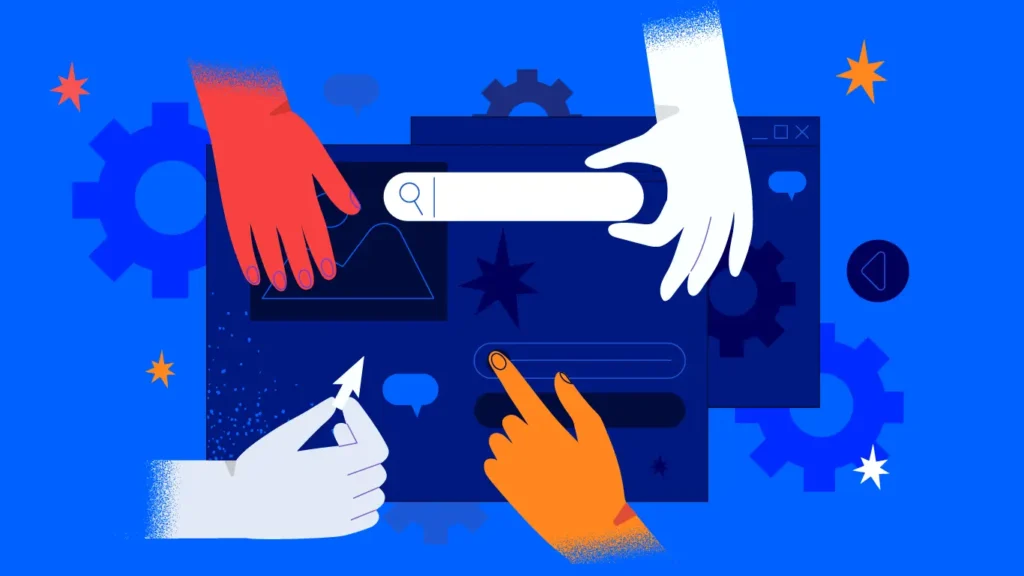Take a moment to think about a website or mobile app you love or enjoy using in your everyday life. Then finish this sentence: “I would tell a friend to use it because it makes it (adjective) for me to (action), and it makes me feel (adjective).”
Chances are, your answer includes words like “quick and easy to use,” “saves me time,” “gives me what I want,” “brings me joy,” “it just works,” etc. The adjectives you used in that sentence encapsulate the purpose and value of good user experience (UX) design.
UX is commonly thought of as creating beautiful, user-friendly products, but it is not always considered a contributor to business success. On the contrary, good UX is a powerful driver for business outcomes beyond aesthetics, helping to increase conversion and retention rates, reduce support costs, build brand loyalty, increase revenue, and give you a competitive edge. A Forrester study claims every dollar invested in UX brings $100 in return.
What is UI vs UX Design?
Let’s start with a quick definition of UI/UX. While UI (User Interface) and UX (User Experience) are often used interchangeably, they refer to distinct product attributes and different aspects of the development process. UX design focuses on understanding user needs to craft smooth, efficient, and intuitive user flows, making applications user-friendly. Meanwhile, UI design ensures that the layout, interactive components, and visual aesthetics are functional, consistent, and accessible.
This article mentions “UX” more often due to its foundational impact on the overall user journey and product usability, but it is important to recognize that UI and UX are two sides of the same coin, working together to create an effective product that fosters engagement, adoption, trust, and loyalty.
Common objections to investing in UX and how to address them
Whether you are considering investing in UI/UX in your product development but not sure if you are making the right investment, or you are advocating for UX investment but are challenged with cost-sensitivity and the need to demonstrate UX’s strategic role and ROI, below are some common objections you may have encountered, and thoughtful responses to consider.
Objection 1: “UI/UX is just about making things look pretty.”
There is often a misconception that UI/UX is only surface-level design and not essential to functionality or business goals, especially for B2B products where brand perception or visual appeal is not considered a priority.
As pointed out earlier, UI/UX goes far beyond selecting colors and font. It involves making sound decisions about navigation, user flows, layout, messaging, and more, all aimed at crafting an effective product that enhances the overall customer experience. A well-designed UI/UX can boost user satisfaction and loyalty.
Conversely, poor UI/UX can lead to confusion, frustration, and errors, resulting in low adoption or abandonment, which may directly impact revenue and brand reputation.
Objection 2: “We are building a B2B or internal tool – UX doesn’t matter to us.”
Industries that are not consumer-facing or businesses building internal tools to support business operations may not consider UI/UX relevant. This is especially true for internal tools, as there may be a belief that this is part of the job function and that employees “have to use it no matter what.”
B2B customers and employees, like you and me, use digital tools in their everyday lives and expect the same intuitive experience and ease of use they experience in consumer applications. Sound user experience can improve operational efficiency, minimize errors, and reduce training and support costs.
Conversely, when confronted with a clunky tool that does not align with business processes or requires extra effort to decipher, users may resort to workarounds with manual workflows or non-sanctioned tools. Not only does your business application become a wasted investment, but your organization can also run the risk of non-compliance, incomplete data, and lack of traceability when users do not adhere to standardized toolsets.
Objection 3: “We already know what our customers want – Our product is working just fine.”
You or your stakeholders may believethey already understand customer needs based on past experiences or intuition, so they see little value in UX research and methodologies. Even if your user segmentation is well-defined, user needs and preferences are complex and nuanced, and they can evolve over time.
Proper due diligence with user research provides insights directly from actual uses to validate assumptions. Meanwhile, iterative design methods like prototyping and user testing allow early experimentation to optimize solutions before implementation. Making UX a priority is essential to building products that resonate with users and remain responsive to their changing needs.
Objection 4: “This is a nice-to-have – we don’t have the time or budget.”
Time-to-market is a priority in today’s competitive digital landscape, and some may see UX as a time-consuming process that slows down product development and requires significant upfront costs. As such, UX may be perceived as an intangible “nice-to-have” rather than a contributor to business success.
Just like investing in an experienced architect when remodeling or building a new house, investing early in a well-designed product can save time and money by minimizing rework and errors during the build.
Design thinking methods such as user research, prototyping, and testing can identify user needs and potential issues upfront, reduce iterations during development, prevent costly redesigns post-launch, and minimize user errors and support calls due to poor user experience. Moreover, launching a product with a positive first impression will increase loyalty and set the stage for a lasting relationship with your customers.
Objection 5: ” UX is hard to measure – I can’t get the buy-in from my stakeholder.”
UX can often seem intangible or esoteric, making it challenging to quantify its impact and justify its value. However, many quantitative and qualitative metrics can measure the ROI of UX improvements. Google’s HEART framework is one notable methodology that offers a structured approach to evaluating user experience. It enables organizations to tie UX improvements directly to quantifiable outcomes and business benefits.
The HEART framework offers actionable insights in 5 dimensions:
- Happiness reflects user satisfaction via NPS, CSAT, or customer feedback, while for B2B users, it might involve productivity gains.
- Engagement measures user interaction through session length and frequency or workflow efficiency and interoperability.
- Adoption tracks new user acquisition, feature usage, or internal tool onboarding.
- Retention examines user loyalty through renewals, continued engagement, or trust in the reliability of B2B tools.
- Task Success evaluates workflow completion rates, error reduction, and support ticket trends, reflecting the efficiency and effectiveness of the UX design. Together, these metrics provide a holistic view of UX performance and identify opportunities for improvement.
Objection 6: “We already have a design team/marketing department.” or “Our developers can handle it.”
Some stakeholders might conflate UX with visual/graphic design work or assume that it is simply part of the technical implementation process. There may be a desire to leverage existing in-house teams or partnerships rather than investing in additional resources and skill sets.
UX goes beyond aesthetics to focus on usability, accessibility, and user satisfaction. Visual/graphic designers have a strong sense of aesthetics and inherent empathy for end-users, and developers likely understand UI patterns and accessibility requirements. However, both UI and UX design require specialized skills such as user research, usability testing, wireframing, and prototyping—all of which go beyond the scope and capabilities of traditional design or development teams.
UI/UX designers professionally trained in user psychology and usability principles, in addition to having a strong design foundation and technology know-how, can effectively deliver high-quality solutions that consider every part of the customer journey and balance user desirability with technical feasibility while addressing the organization’s strategic goals.
Summarizing the value of UX
The value of investing in an intuitive User Experience (UX) and well-designed user interface (UI) can be significant and multifaceted, impacting various aspects of an organization. According to the Gartner UX Value Framework, the value of UX can be demonstrated from four perspectives: the business, the brand, the customer, and the employee.
Business value: UX can directly influence the bottom line by increasing revenue and reducing costs. Higher conversion, adoption, and retention boost financial gains. Intuitive design requires less training and reduces user errors, minimizing support costs, while iterative design approaches streamline development costs by avoiding costly rework.
Brand value: UX influences brand perception and loyalty. Consistent user experience and visual design create a memorable interaction that reinforces the brand image and builds trust. Customers who have a positive experience with a product or service are more likely to recommend it to their friends and family.
Customer value: UX impacts customer satisfaction and usability. Intuitive navigation, aesthetically pleasing elements, and interactions that feel seamless and responsive contribute to a satisfying user experience. Tools like the System Usability Scale (SUS) can evaluate how easy and enjoyable a product is to use, which can predict future customer behavior and satisfaction.
Employee value: UX also affects employee sentiment and productivity. Well-designed UI/UX can significantly enhance productivity by reducing time to task completion, minimizing errors, and reducing training time. Employees are more likely to take pride in their work, and the tools they use, and higher employee satisfaction leads to higher performance and lower attrition rates.
Investing in UX is not just a nice-to-have; it is a must-have in today’s competitive and user-centric landscape. By making UX a strategic priority, you are not just creating better products–you are building stronger relationships with your customers, empowering your employees to perform at their best, driving sustainable growth, and establishing a brand that users will love and trust.


















